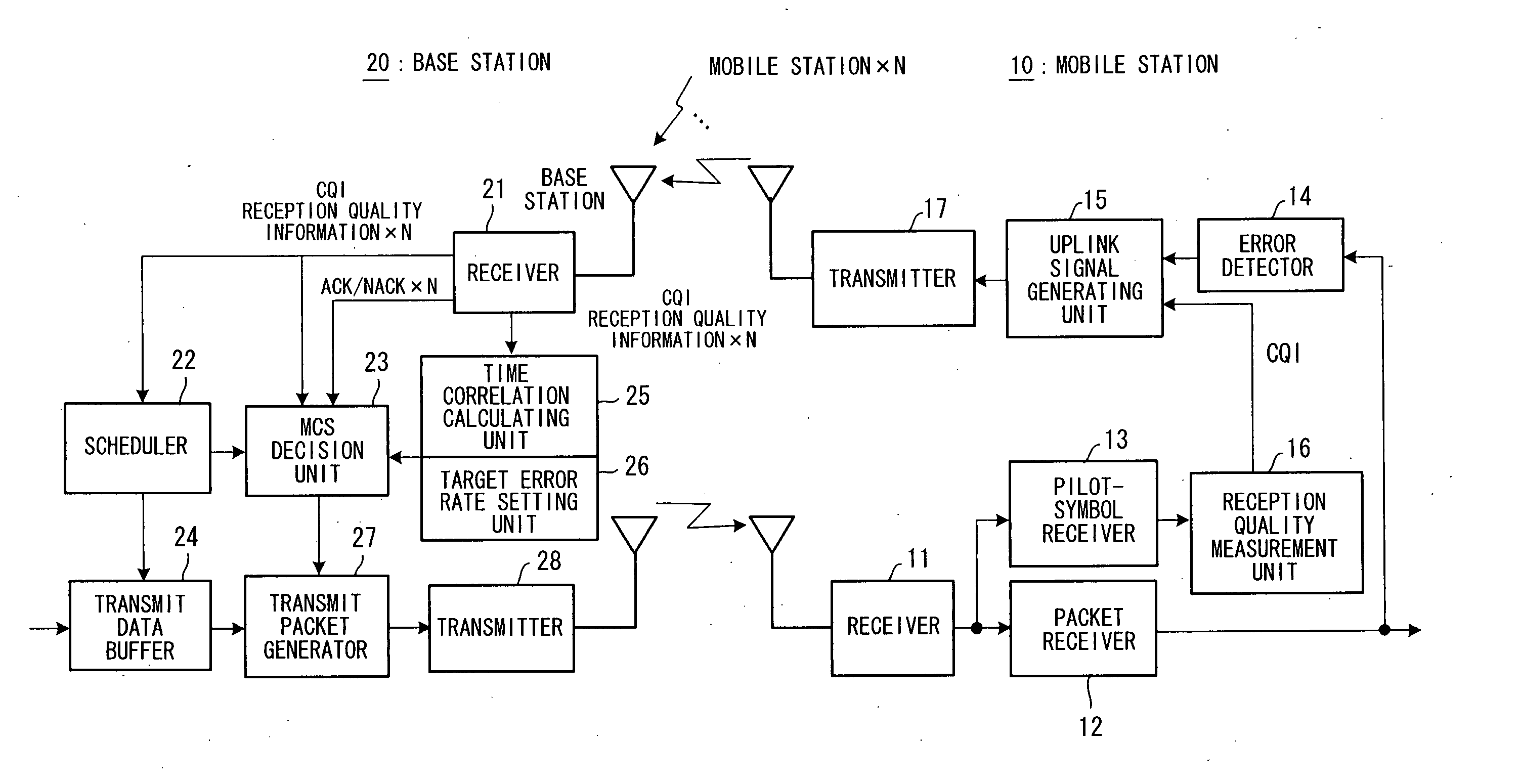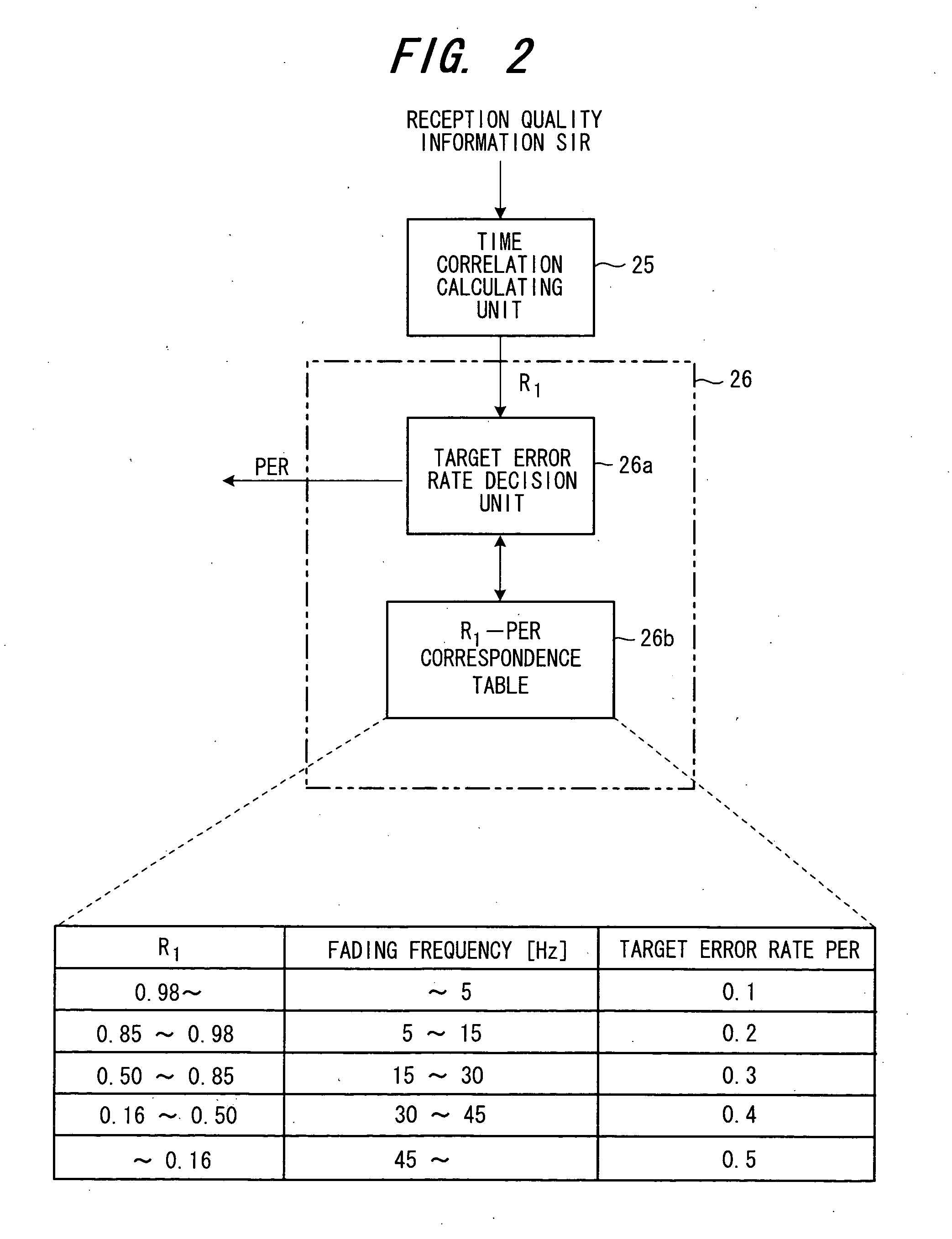Radio communication apparatus
a technology of radio communication and communication apparatus, which is applied in the direction of phase-modulated carrier systems, wireless communication services, coding, etc., can solve the problems of increasing the size of information data transmitted, achieving the target error rate, and achieving reception error rates
- Summary
- Abstract
- Description
- Claims
- Application Information
AI Technical Summary
Benefits of technology
Problems solved by technology
Method used
Image
Examples
first embodiment
(B) First Embodiment
FIG. 1 is a block diagram illustrating the configuration of a radio packet communication system according to a first embodiment of the present invention.
As shown in FIG. 1, a mobile station 10 has a receiver 11 for receiving a high-frequency signal sent to it from a radio base station 20, converting the signal to a baseband signal and inputting the baseband signal to a packet receiver 12 and pilot-symbol receiver 13. The packet receiver 12 demodulates encoded packet data, applies decode processing and inputs the decoded signal to an error detector 14. The latter performs error detection using an error detecting code (CRC code) contained in the decoded signal and inputs the result of detection to an uplink signal generating unit 15. Meanwhile, the pilot-symbol receiver 13 extracts a pilot symbol and inputs the symbol to a reception quality measurement unit 16. The latter measures the SIR (Signal to Interference Ratio) as the reception quality of the radio downli...
second embodiment
(C) Second Embodiment
FIG. 3 is a block diagram illustrating the configuration of a radio packet communication system according to a second embodiment of the present invention, in which components identical with those of the first embodiment are designated by like reference characters. This embodiment differs only in the method of calculating the time correlation and the method of setting the target error rate and is the same as the first embodiment in other respects.
A time correlation calculating unit 31 obtains a time correlation value R2 of the downlink reception quality information in accordance with the following equation: R2=〈Re[s(t+τ)*s(t)]〉〈s(t)2〉(6)
and inputs the value R2 to a target error rate setting unit 32. In Equation (6), s(t) represents a complex uplink pilot symbol that prevails after pilot pattern cancellation, t a time interval at which the time correlation is acquired, Re[ ] a function for taking the real part of a complex signal, and <X> the average...
third embodiment
(D) Third Embodiment
In radio communication, signals from a transmitter are reflected, diffracted and scattered by objects in the vicinity of the receiver, resulting in a multiplexed propagation path. A large number of waves that arrive at the vicinity of the receiver from various directions interfere with one another so that a random standing-wave electromagnetic distribution is formed. When a mobile station travels through such an electromagnetic distribution, a phenomenon referred to as fading, in which the amplitude and phase of received waves fluctuate randomly, occurs. In an ideal fading environment, the time correlation values R1, R2 in Equations (5), (6) and the fading frequency fD decided by the travelling speed of the mobile station are related as indicated by the following Equations (7), (8), respectively:
R1={J0(2πfDτ)}2 (7)
R2=J0(2πfDτ) (8)
where fD represents the fading frequency [Hz], τ the time interval of the correlation, and J0(X) a Bessel function of degree 0. ...
PUM
 Login to View More
Login to View More Abstract
Description
Claims
Application Information
 Login to View More
Login to View More - R&D
- Intellectual Property
- Life Sciences
- Materials
- Tech Scout
- Unparalleled Data Quality
- Higher Quality Content
- 60% Fewer Hallucinations
Browse by: Latest US Patents, China's latest patents, Technical Efficacy Thesaurus, Application Domain, Technology Topic, Popular Technical Reports.
© 2025 PatSnap. All rights reserved.Legal|Privacy policy|Modern Slavery Act Transparency Statement|Sitemap|About US| Contact US: help@patsnap.com



